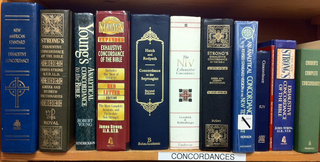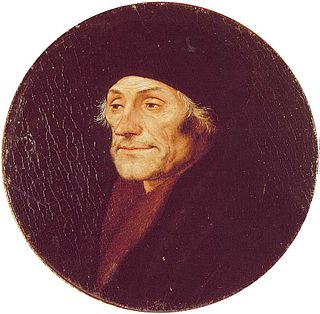
The King James Version (KJV), also the King James Bible (KJB) and the Authorized Version (AV), is an Early Modern English translation of the Christian Bible for the Church of England, which was commissioned in 1604 and published in 1611, by sponsorship of King James VI and I. The 80 books of the King James Version include 39 books of the Old Testament, 14 books of Apocrypha, and the 27 books of the New Testament.

The Septuagint, sometimes referred to as the Greek Old Testament or The Translation of the Seventy, and often abbreviated as LXX, is the earliest extant Greek translation of the Hebrew Bible from the original Hebrew. The full Greek title derives from the story recorded in the Letter of Aristeas to Philocrates that "the laws of the Jews" were translated into the Greek language at the request of Ptolemy II Philadelphus by seventy-two Hebrew translators—six from each of the Twelve Tribes of Israel.

The Vulgate, sometimes referred to as the Latin Vulgate, is a late-4th-century Latin translation of the Bible.

The Geneva Bible is one of the most historically significant translations of the Bible into English, preceding the King James Version by 51 years. It was the primary Bible of 16th-century English Protestantism and was used by William Shakespeare, Oliver Cromwell, John Knox, John Donne and others. It was one of the Bibles taken to America on the Mayflower, and its frontispiece inspired Franklin's design for the first Great Seal of the United States.

Vetus Latina, also known as Vetus Itala, Itala ("Italian") and Old Italic, and denoted by the siglum , is the collective name given to the Latin translations of biblical texts that preceded the Vulgate.

The Complutensian Polyglot Bible is the name given to the first printed polyglot of the entire Bible. The edition was initiated and financed by Cardinal Francisco Jiménez de Cisneros (1436–1517) and published by Complutense University in Alcalá de Henares, Spain. It includes the first printed editions of the Greek New Testament, the complete Septuagint, and the Targum Onkelos. Of the 600 six-volume sets which were printed, only 123 are known to have survived to date.

Konrad Pellikan was a German Protestant theologian, humanist, Protestant reformer and Christian Hebraist who worked chiefly in Switzerland.

A polyglot is a book that contains side-by-side versions of the same text in several different languages. Some editions of the Bible or its parts are polyglots, in which the Hebrew and Greek originals are exhibited along with historical translations. Polyglots are useful for studying the history of the text and its interpretation.

The Plantin Polyglot is a polyglot Bible, printed under the title Biblia Polyglotta by Christopher Plantin in Antwerp (Belgium) between 1568 and 1573.
German language translations of the Bible have existed since the Middle Ages. The most influential is Luther's translation, which established High German as the literary language throughout Germany by the middle of the seventeenth century and which still continues to be most widely used in the German-speaking world today.
Jewish printers were quick to take advantages of the printing press in publishing the Hebrew Bible. While for synagogue services written scrolls were used, the printing press was very soon called into service to provide copies of the Hebrew Bible for private use. All the editions published before the Complutensian Polyglot were edited by Jews; but afterwards, and because of the increased interest excited in the Bible by the Reformation, the work was taken up by Christian scholars and printers; and the editions published by Jews after this time were largely influenced by these Christian publications. It is not possible in the present article to enumerate all the editions, whole or partial, of the Hebrew text. This account is devoted mainly to the incunabula.

A Bible concordance is a concordance, or verbal index, to the Bible. A simple form lists Biblical words alphabetically, with indications to enable the inquirer to find the passages of the Bible where the words occur.

Novum Instrumentum Omne, later called Novum Testamentum Omne, was a bilingual Latin-Greek New Testament with substantial scholarly annotations, and the first printed New Testament of the Greek to be published. It was prepared by Desiderius Erasmus (1466–1536) and printed by Johann Froben (1460–1527) of Basel.
The Apostolic Bible Polyglot (ABP), originally published in 2003, is a Bible translation by Charles VanderPool. The ABP is an English translation with a Greek interlinear gloss and is keyed to a concordance. The numbering system, called "AB-Strong's", is a modified version of Strong's concordance, which was designed only to handle the traditional Hebrew Masoretic Text of the Old Testament, and the Greek text of the New Testament. Strong's concordance doesn't have numbering for the Greek O.T. The ABP utilizes a Greek Septuagint base for the O.T. and, therefore, required a modified system. The numbers and the Greek word appear immediately above the English translation instead of side by side, as is common in many interlinears.
Samuel Bagster the elder was the founder of the publishing firm of Bagster & Sons.

Agostino Giustiniani was an Italian Catholic bishop, linguist and geographer.
Bible translations into Hebrew primarily refers to translations of the New Testament of the Christian Bible into the Hebrew language, from the original Koine Greek or an intermediate translation. There is less need to translate the Jewish Tanakh from the Original Biblical Hebrew, because it is closely intelligible to Modern Hebrew speakers. There are more translations of the small number of Tanakhas passages preserved in the more distantly related biblical Aramaic language. There are also Hebrew translations of Biblical apocrypha.
The initiator of Esperanto, L. L. Zamenhof, translated the entire Hebrew Bible into Esperanto. His translation has been much admired by Esperantists and is widely held up as a model or exemplar for other Esperanto authors and translators. Other translators have also edited and published Esperanto versions of the New Testament and Apocrypha.

Cornelis Kiliaan, was a 16th-century lexicographer, linguist, translator and poet of the Southern Netherlands.












